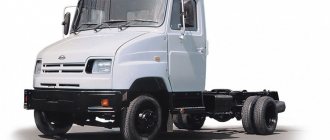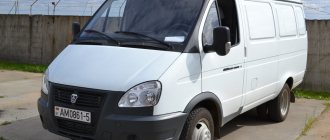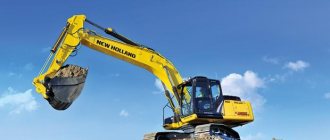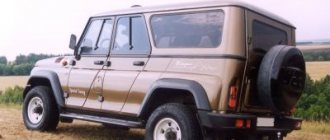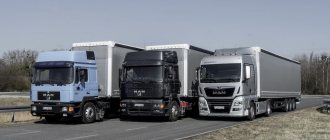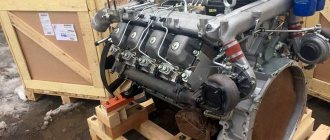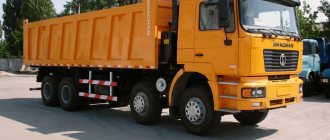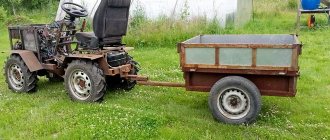The MAN TGA truck tractor already has quite a long history and serious popularity. Such tractors were officially produced until 2007, and then this series, which had already gained noticeable fame, lost its position to a new series of trucks. They turned out to be the famous MAN TGH cars, which made a splash even at the presentation. However, it was the TGA model that became the basics for the main TGC designs. MAN TGA is considered the generation of trucks that stood at the very origins of the concept, which was introduced by engineers from MAN. We're talking about the Trucknology Generation.
The abbreviation of this word is the TG marking, and the load capacity class of the truck is determined by the last letter “A”; for this series this parameter is more than 18 tons. The definition of “Trucknology Generation” implies that generation of trucks, the main goal of which is a combination of the highest automotive technologies, “intelligent” control and impeccable comfort. The MAN TGA vehicle fully meets these parameters.
This truck was originally invented directly in search of additional auxiliary power for the MAN F2000 series. Later, the TGA was already an equivalent replacement for the F2000 model, which at that time was already losing its relevance. In the new series of cars, environmental characteristics were improved (up to EURO 5), and new engines appeared. For 7 years, MAN presented this model as advanced.
Man TGA - technical specifications
In fact, the MAN TGA has quite a lot of work tasks, but there are also highly specialized ones among them. Accordingly, listing all its options can fit into a decent list. The total permissible weight, designated 18 tons, is not a limit either. The “heavyweight” series also includes tractors in which this parameter reaches 32-41 tons, and the wheel formulas are 8x8, 8x6, 8x4. In these cases, the actual mass of the road train is equal to 250 tons.
Lightweight options have a wheelbase from 4x2 to 6x4. This also includes 4x4 all-wheel drive. These vehicles are in demand as long-haul tractors or trailers, dump trucks or garbage trucks. A tractor is used as a concrete mixer or a loading platform to transport emergency, fire and other special equipment.
For example, model 18.440 offers engines with a maximum power of 440 hp. The modifications also use other powers: 360, 400, 480, 660 hp. Increased traction is made possible by the 18-liter 10-cylinder MAN D2840 LF engine. These powers are located on a spring-pneumatic suspension. Previously, the MAN TGA model was equipped with engines of the D2066 series, the displacement of which was 10.5 liters. Later they were replaced by 12-liter diesel units with the following parameters:
- Output power - 440 - 540 hp;
- Compliance with EURO 4 and Euro 5;
- Torque 2100-2500 Nm at 1050-1400 rpm;
- The engine had an exhaust exhaust recirculation (EGR) system.
What to do if MAN stalls
Timely maintenance of MAN TGS and other models does not protect against breakdowns on the move, but eliminates the cause of malfunctions and reduces the risk of emergency situations on the road.
If the MAN does not accelerate, stalls at speed, or does not start with the key without pumping, you need to solve the problem as quickly as possible. Specialists at the service station will help with this, but the owner will lose time on repairs. The specialists of “Cargo Service 24 Volt” will use computer diagnostics on site to determine why the MAN does not start, and will eliminate mechanical breakdowns and hardware failures. You can read about auto electrician services here.
Call, call service specialists, receive qualified technical assistance on site. Customers are guaranteed diagnostic accuracy, reliable repairs, and affordable prices.
MAN TGA - Cabin (photo)
Similar to the Trucknology Generation series vehicles, the TGA has three different cab options. Since the machine is very often used for work in urban areas, the most popular is the day cab.
Cabin markings:
- For city models, the cabin is marked “M”, for highway models – “LX”.
- Trunk models are divided into XLX or XXL size cabins (with two sleeping bags).
One of the most important aspects in a car is the electronics, as well as all the control systems. It's hard to imagine an ultra-modern tractor without cruise control and an on-board computer. These devices are also available from MAN TGA. In addition, the truck is equipped with a mountain brake, automatic transmission, and anti-lock wheels, which help minimize braking distances and increase vehicle stability. Taking into account the cold climate conditions, German manufacturers made the heating system completely autonomous; in addition, they installed air conditioning and heated seats. For greater convenience when crossing long distances, a refrigerator, CD radio and walkie-talkie were installed in the tractor cabin. The kit includes fog lights, heated mirrors, and electric window lifts. Manufacturers have provided functional solutions for urban conditions. For example, a plastic bumper includes three parts. This will significantly save time and money in the event of repairs. Also, for work on construction sites, the car's headlights are equipped with protective grilles.
Read also: Iveco Trucker error codes
The style and design of the MAN TGA truck can definitely be called businesslike in German. The almost square cabin, which has narrow headlights and a radiator grille, has straight lines. A convenient visor protects the voluminous windshield. The view of the road is successfully complemented by massive side mirrors. This austere look is complemented by bright and eye-catching paintwork, making the MAN TGA easy to recognize in a crowd of trucks.
Modern trends are fully revealed in the MAN TGA 2014 model. Last year, at a transport conference, MAN TGA received the “Truck of years” award, which, according to tradition, is awarded annually to the best truck models.
Common truck problems
If the MAN starts and stalls, then in addition to problems with the fuel system, you should look for the cause in the ignition or starter (in this case, the panel may be error-free). Low-quality fuel also leads to a similar problem. MAN TGA, Commander, F2000 does not start due to damaged wiring, which causes the sensors to malfunction. For prevention, it is recommended to measure the voltage in the network and check the connection of control elements.
If the truck jerks, you need to pay attention to the clutch (a clear sign of a malfunction is pedal play). The engine does not operate stably at idle when there are problems with the intake of the air system, as well as:
- the fuel pressure regulator is faulty - a breakdown is indicated by a drop in power when the gas pedal is sharply pressed;
- the injectors are clogged.
When a fuse regularly blows, you need to pay attention to its compatibility with the network and contacts. If this is all right, you should find the cause of the power surge.
MAN TGA - T.O. before starting the engine
Daily:
- Engine: Check oil level.
- Cooling system: Check fluid level.
- Fuel tank: Check fuel capacity.
- Equipment and signaling system: Check condition and functionality.
- SSU, sockets and connection heads: Check condition and functionality.
- Sliding support, connecting cables and wires: Check condition and functionality.
Weekly:
- Tires and wheels: Check pressure and condition.
- Wheel nuts: Check that they are firmly seated.
- Glass and headlight cleaner: Add liquid, check functionality.
- Engine, gearbox, transfer case, drive axle, steering, cooling and heating system: Check for leaks
- Fuel coarse filter: Remove moisture.
Monthly:
- Engaging the clutch and gearbox: Check the oil level.
- Beka-Max centralized lubrication system: Check lubricant level.
- V-belt: Check condition.
Once every six months:
- Batteries: Check electrolyte level.
- Fuel tank: Remove moisture.
- Cab tilt mechanism: Check oil level.
MAN TGA - owner reviews
Valentin from Ivanovo (MAN TGA 2005).
The truck tractor purchased in Yekaterinburg already had a mileage of 350 thousand km. Speaking of features, it should be noted that the car has an automatic transmission, an included audio system, ABS, heated mirrors, a Webasto oven and a mini-fridge. For intercity travel, the car is used with an isothermal trailer, like a mainline tractor.
Disadvantages of MAN TGA:
- EURO 5 is fastidious for diesel fuel and oils.
- All filters should be monitored at all times.
- In some places the plastic is of poor quality.
- Fairly simple design.
- Diesel noise can be heard in the cabin.
- Service maintenance (original German spare parts) costs about 500 euros.
- There are some shortcomings in the automatic transmission - it slows down when switching, and reacts to low temperatures.
However, the owner also notes the advantages of this brand of car.
Advantages of MAN TGA:
- First of all, German quality stands out.
- The machine is unpretentious and designed for working conditions in Russia and the CIS.
- Excellent visibility, decent ground clearance, a small turning angle and modern systems - these advantages make work much easier.
- Large free space in the XXL cab and an available sunroof.
- Drivers often note the comfortable design of the seats, as well as the multifunctional steering wheel.
Of course, the car is an acceptable option in terms of cost and quality. On the used market it is possible to buy a car at an affordable price.
How to identify the cause of pressure loss
The MAN does not start well when hot, when it cools down, it stalls while driving due to low pressure (compression). There are 4 leak points:
- damage to the gasket, engine cylinder head;
- depressurization of the intake valve;
- exhaust valve wear;
- pistons, piston rings.
Then the injection pump is checked. If the car does not have a catalyst installed, the efficiency of the pump can be checked by the presence of fuel drops in the exhaust pipe. Another option is to remove the glow element (if there is one) and activate the injectors to see how the fuel is sprayed. You can read more about the diagnosis of Man here.
MAN TGA: video test drive
MAN TGA trucks weighing up to 50 tons have been produced since the distant year 2000. Despite its rather advanced age by automotive standards, the MAN TGA is one of the most popular trucks on the world market. This truck can have a chassis with the following wheel configurations: 4×2, 6×2, 6×2/2, 6×2/4, 6×4.
MAN TGA trucks are not necessarily used for transporting heavy construction materials. There are mainline versions, and also on the basis of TGA, MAN produces trucks for municipal services, in particular garbage trucks, which are specially equipped with a more comfortable cab with a low floor and doors, as well as a slightly modified chassis.
Trunk versions of MAN TGA have two berths and come in different types: L, XLX and XXL. The length of the sleeping berth in this car is 2,200 millimeters and the width is 790 millimeters. The cabin height in the XXL version is 2,200 millimeters, in the XLX version it is 1,975 millimeters.
The main engine for the MAN TGA is a six-cylinder diesel engine with a displacement of 10.5 liters. Depending on the version of the truck, the engine can have power from 310 to 440 horsepower. There is a version of this truck with a more solid engine – 12.8 liter. The power of such an engine, depending on the configuration, will be either 480 horsepower or 530 horsepower.
Read also: Sprockets for loosening bolts
All MAN motors are famous not only for their technical data, but also for their quality of execution. The engines of this company are among the most durable and economical, but at the same time, they are not so large in size when compared with competing modifications of trucks. MAN TGA are equipped with a 12-speed automated manual transmission or a fully manual transmission with 16 gears.
The MAN truck line also includes a heavier MAN TGX model, which is the company’s flagship, and some buyers choose the MAN TGS model, which is more suitable for their working conditions.
OPERATING EXPERIENCE OF MAN F2000 AND MAN TG-A
In addition, carriers are particularly interested in the new TG-A family of trucks, which are also gradually expanding into Russian space. What kind of car? What are the design and operation features? How do the numerous electronic systems with which the car is richly equipped perform in our conditions? We will also try to answer these questions.
For information, we contacted the transport company, which operates several MAN tractors of both the TG-A and F2000 series. Let's start with the F2000 series trucks, which travel on our roads in large numbers.
MAN F2000 and MAN F2000 Evolution.
Heavy duty F2000 series trucks appeared in the MAN program in the fall of 1994. In 1998, these cars underwent modernization (the design of the cabin was slightly changed, new engines, gearboxes and drive axles appeared), after which the prefix Evolution was added to the model name.
The transport company currently operates two MAN F2000 18.403 tractor units, manufactured in 1998, and three F2000 18.463 Evolution series vehicles, manufactured in 2002. The first two cars were purchased used in 2000, with mileages of about 330-350 thousand km, and the same number of cars managed to travel across Russia. Moreover, new cars today have a mileage of about 300 thousand km.
The trucks are equipped with the most spacious cabs with high roofs and two berths. The length of such a cabin is 2205 mm, width 2440, internal height 2170 mm. In terms of convenience, there are no complaints about the cabins. However, there are comments on other points. On all cars, at the wiring harness coming out of the cab near the driver’s feet, in the gap between the frame and the cab, the braid constantly breaks and the wires begin to fray. In addition, in winter, when lifting the cabin, the “stiffened” wires and their braiding also often break. Therefore, before lifting the cabins, this harness is unfastened.
The cab suspension is completely pneumatic, with anti-roll bar. The cabin air springs are combined into one unit with shock absorbers, which on our roads are enough for about 150 thousand km. Then the shock absorbers begin to leak, and the entire unit has to be replaced. The bushings and silent blocks of the cab front suspension can withstand a mileage of only 100 thousand km.
MAN F2000 tractors manufactured in 1998 are equipped with 6-cylinder 12-liter sixes D2866 LF21 with a power of 400 hp, meeting Euro-2 standards. The 2002 Evolution series trucks have more modern and powerful engines with four valves per cylinder. Engines of the D2876 LF04 series with a volume of 12.8 liters develop 460 hp. (torque is 2100 Nm at 900 rpm) and meet Euro-3 standards. One of the main problems for, perhaps, any foreign diesel engine operating in Russia is poor diesel fuel with a high sulfur content. We produce winter fuel in small volumes, and it often appears by spring. In addition, in Russia, at a decent-looking gas station, you can easily fill the tank with diesel fuel and water. For example, one company car, returning from a flight, took a sip of this “swill” at a gas station near St. Petersburg and, as a result, the engine fuel injection pump “died” on the move. The renovation cost $4,000.
Given such conditions, the manufacturer recommends checking the operation of the injectors every 100 thousand km. True, the transport company does this once every 200 thousand, since they managed to experimentally find gas stations with more or less decent fuel. The installation of an additional heated fuel filter-separator contributed to lengthening the intervals. But the timing of changing oil (synthetic) in engines at the company, on the contrary, was halved - from 80 thousand km (in Europe) to 40-45 thousand km.
In addition, the manufacturer recommends that after a mileage of 600 thousand km, remove the cylinder heads, check the gap between the cylinder block and the liner, and, if necessary, install special compensation rings. At the same time, it is worth changing the piston rings and crankshaft liners. Of course, you don’t have to do this, but then wear may increase, compression and power will begin to drop, and at about 800 thousand km it is quite possible to “arrive” for serious repairs.
All three new MAN F2000 Evolution trucks, whose engines meet Euro-3 standards, had problems with the fan clutches. These new generation clutches are electrically controlled: when voltage is applied to the solenoid valve, the clutch opens, and when the voltage is removed, it is locked. Due to a factory defect, this solenoid valve failed and stopped responding to voltage, the clutch remained blocked, and the fan kept spinning. In summer there is no particular harm from this, but in winter it threatens to overcool the engine. The factory recognized its defect, and all couplings were replaced under warranty. By the way, there have been no such problems yet on the MAN TG-A trucks operated by the company, which have the same engines. And on one old F2000 tractor with a Euro-2 engine, where the fan drive clutch control was still pneumatic, an atypical breakdown occurred. With a mileage of 600 thousand km, the control pneumatic cylinder fell off the clutch and broke the clutch itself and the radiator.
In addition, on the new Evolutions, with a mileage of 50 thousand km, air compressors began to drive oil into the pneumatic system. But this is already a reproach to component manufacturers, who often supply insufficiently reliable components to the assembly line.
Not much can be said about the chassis. After approximately 150-170 thousand km, the lower rubber bushing on the front shock absorber breaks. True, the bushings themselves can be changed, which is cheaper than buying a new shock absorber. Anti-roll bar bushings can withstand about 300 thousand km on our roads. The steering pins “go” for about the same amount of time. One of the used F2000s also had a rather unusual failure: the frame cross member under the gearbox was cracked in the area of the fasteners. The crossbar itself is secured with 8 bolts, so replacing it is not difficult.
MAN TG-A.
At the end of 2000 - beginning of 2001, MAN had a new flagship - the TG-A family of heavy trucks with a gross weight of 18 tons, designed to replace the F2000 Evolution series. The concern invested more than 1 billion German marks in the development of these largely unique trucks, which was the largest amount invested in the development of new vehicles in the entire history of the company! What happened in the end?
The company we contacted for information operates 3 TG-A truck tractors, which were purchased new. First, a MAN TG-A 18.460 truck with an XXL cab, produced in 2001, was purchased. Now this tractor has covered 300 thousand km. Two other tractors - TG-A LX 18.460 - were purchased at the end of 2002 and currently have a mileage of around 100 thousand km. The mileage is not very high yet, but there are already reviews on the cars.
Cabin.
The 2001 truck is equipped with the largest and most comfortable of the 5 types of cabs offered for the TG-A - the XXL version with a high roof. It’s not for nothing that this cubic cabin is called the most spacious among European trucks. With a length of 2280 mm and a width of 2440 mm, the internal height of the cabin in the area of the engine tunnel is 210 cm. At the same time, the height of the engine tunnel itself is only 10 cm. The size of the lower bunk is 2200x790 mm, the upper one is 2125x705 mm. The standard equipment already includes a pull-out refrigerator under the lower bed, as well as electric windows and a sliding sunroof.
With all the advantages and convenience, a large cabin also has a downside. The XXL cab suspension is completely pneumatic, with individual control of each air spring, which is supposed to compensate for the lack of anti-roll bar. However, on bad roads and when braking, the heavy cabin still sways a lot. And there is no information yet that MAN has developed a reinforced version of the cabin air suspension.
During the operation of the machine, the company also received additional service information from the factory about what is worth paying attention to. Thus, the manufacturer recommended replacing the door hinges, which turned out to be very weak. Indeed, on the first TG-A, the door hinges became so loose that the axle on one of the hinges broke off.
When purchasing two new tractors from the company, taking into account previous experience, we decided to give preference to 2-bed cabins of the LX series. While the same length as the XXL cab, the LX version is lower, 20cm narrower and ultimately much lighter than the top variant. And practice shows that the LX cabin, while maintaining a high level of comfort, is much less prone to swaying.
Engine.
All three TG-A tractors of the company are equipped with engines of the D2876 LF04 series of Euro-3 standard, which have proven themselves since 1998 on the previous model F2000 Evolution. Six-cylinder 24-valve turbodiesels with a volume of 12.8 liters have a power of 460 hp. and develop a torque of 2100 Nm at 900 rpm.
The engines continue to use a traditional in-line high-pressure fuel pump (HPV) with electronic control. To bring the engine up to the Euro-3 environmental standard, the company's engineers, instead of using pump injectors or other fuel systems, simply equipped the engine with an exhaust recirculation system. From the exhaust manifold, part of the gases is discharged into the heat exchanger, cooled there to 200oC and then fed back into the intake manifold, mixing with fresh air entering the engine. This solution makes it possible to reduce the content of nitrogen oxides in exhaust gases by 30%.
The environment is clear. How do engines perform in operation, especially in winter?
At idle speed (approximately 600 rpm), the diesel engine, due to its design features, cools quickly. So without turning on the “autonomy” it becomes very cool in the cabin. Although there is another option, if you don’t want to turn on the autonomous heater, raise the idle speed using electronic cruise control so that the engine starts to warm up.
The standard electric torch device allows you to start the engine at temperatures down to -27oC without any problems. It is important to remember that using ethers when starting is strictly prohibited. The fuel filters and filter-moisture separator are also heated. But, according to the operators, in our conditions it would be useful to install an additional heater for the fuel intake. However, at temperatures below - 30oC, if possible, it is advisable to place the car in a warm room, otherwise, as practice shows, it is no longer possible to start the engine without outside help. There’s nothing to be done - that’s the kind of fuel we have in our country...
Also, problems have repeatedly arisen when returning trucks from trips in the direction of the Krasnodar Territory, where there is no winter solar power at all. And drivers often had to add kerosene to the fuel.
Regarding fuel consumption, the following should be said. Although the vehicles are equipped with aerodynamic fairings, deficiencies in the organization of traffic and the deplorable condition of the roads lead to the fact that, for example, the winter fuel consumption (according to the operating company, based on readings from the on-board computers of the trucks) of a run-in TG-A truck with an XXL cab, towing a fully loaded 20-ton refrigerator is 41-42 liters per 100 km. The consumption of trucks with LX cab is approximately 38-40 liters per 100 km. (We have doubts about these indicators. - Ed.)
The company uses synthetic oils of the SAE 5W40 type in car engines. Topping up is on average 1-2 liters per 10 thousand km. mileage But, as in the case of the F2000 Evolution trucks, due to the increased sulfur content in the fuel and dirt on the roads, the company halved the oil change time compared to the manufacturer’s recommendations.
There were also more serious problems. On two new TG-A, released in 2002, after a mileage of 80-90 thousand, the same upper gaskets (there are three in total) in the rear heads of two-cylinder air compressors almost simultaneously broke through. And a little later, on the first TG-A of 2001, everything was exactly repeated - on the same head, with the same gasket. The malfunction manifests itself as follows. After a gasket breakdown, the compressor begins to pump air not only into the pneumatic system, but also into the cooling system. This air exits through the expansion tank, so after stopping the engine you can hear the pressure relief valve releasing excess air pressure from the cooling system. When the engine is running, coolant may begin to leak through this valve. In turn, after the gasket is damaged, the coolant enters the pneumatic system, as can be seen from the marks on the pressure regulator. The compressor heads themselves can be disassembled, but a separate repair kit for gaskets is not provided for them, so the head can only be replaced as an assembly. In response to complaints received, MAN recommended that these heads be pulled through.
During operation, the 2001 TG-A also had a charge air cooler (intercooler). This was expressed in the fact that while driving the engine sharply lost power and stopped developing speed. The problem was explained simply. According to the MAN specialists themselves, they made an intercooler radiator with too large a cooling area. During the transition period (autumn-winter), with high humidity and mild frost, air with condensation, passing through the radiator, cooled sharply and froze in it. As a result, the rubber air ducts at the outlet of the intercooler were compressed due to vacuum, which caused a drop in the volume of air supplied to the engine. After warming up the intercooler, everything was restored, but this did not completely solve the problem. Therefore, in agreement with the factory, a hole was drilled at the lowest point of the intercooler at the lowest point of the intercooler to drain the condensate, and the intercooler radiator itself was partially covered with cardboard for the winter, which solved the problem. By the way, the plant, taking into account its shortcomings, has already begun installing intercoolers with a reduced cooling area on subsequent cars.
Gearbox and chassis.
Trucks of the TG-A family are offered as standard with a 16-speed ZF ComfortShift gearbox with pneumatic booster and hydraulic drive. An optional 12-speed TipMatic automated manual transmission with electronic control is available. The company's trucks are equipped with a third option - a unique 16-speed MAN ComfortShift gearbox with the HGS hydrostatic gearshift system.
The peculiarity of this box is that the driver uses the clutch pedal only when starting the truck or for maneuvering. While driving, the driver simply presses a button on the knob of the gearshift lever before shifting. After pressing the button, the pneumatic drive, at the command of the electronic control unit, first turns off, and after the driver has changed gear, turns on the clutch.
The gear shift drive on this box is hydraulic. Under the gearshift lever itself, instead of traditional cables or mechanical rods, there is a block of control hydraulic cylinders. When the gearshift lever moves, this block with four cylinders accordingly distributes the working fluid through pipelines to two actuator hydraulic cylinders, which are responsible for engaging a certain number of gears. The hydraulic fluid itself (called pentazine) is compatible with transmission oil. This was done to prevent failure of the gearbox in the event of a leak in the slave cylinder.
There is no doubt that such a transmission makes a driver’s everyday life a lot easier, but there were problems with it too. So, in winter, on a cold car, the hydraulic cylinder block of the gearshift lever “freezes”, which causes difficulties with shifting gears. An electric heater is installed in the block itself, which restores the functionality of the gearbox in 10-15 minutes. Although, according to the operators, it would be useful to additionally insulate this block or install a more powerful heater in it.
The valve that controls the clutch pneumatic actuator is located next to the clutch master cylinder, and this valve was exposed to water flowing down the cabin. Several times during the winter, the outlet of this valve became covered with ice and it could not relieve pressure. As a result, the clutch remained depressed and did not engage. At first the valve was warmed up, and then simply covered from the water - and the problem disappeared.
Truck brakes are disc brakes on all wheels, with ABS, PBS, electronic control and pad wear sensors. Disc brakes make it possible to reduce the braking distance of a road train by 10 meters from a speed of 80 km/h. According to the plant, with the combined use of an engine brake and transmission retarder, the pads can withstand a mileage of up to 600 thousand km.
During the next maintenance (approximately 180 thousand km) on a 2001 TG-A, uneven wear of the brake pads on the drive axle was revealed. Upon inspection, it turned out that the inner pads were more worn than the outer ones, but the anthers were not damaged. No obvious cause for the uneven wear was ever discovered. The units were replaced in Germany under warranty. In addition, the front tires of the same truck showed increased wear on the second tracks on the outside. Specialists at the MAN factory station in Munich changed the settings for the front wheels and the problem no longer occurred.
The 2001 TG-A tractor suspension has leaf springs at the front and 4 air springs with ECAS electronic control at the rear. On two TG-A trucks produced in 2002, instead of springs, the Sachs suspension, used for the first time in the truck industry, is installed in front, in which the air spring and shock absorber are combined into one unit. A tractor with such a suspension is well suited for transporting fragile goods (for example, electrical goods) due to its softer ride, and it is also more comfortable. But on our “wavy” roads, the handling of a truck with such a suspension deteriorates, and the vehicle begins to noticeably “float”. Other than that, all three trucks have had no problems with their suspensions so far.
In conclusion, about electronics, which not only Russian, but also European drivers are so afraid of. TG-A trucks are literally packed with it. Even instead of an oil dipstick, there is an electronic sensor installed here! The electronics control the operation of engines, gearboxes, brakes and suspensions, using three multiplex CAN buses for data exchange, which greatly reduces the number and weight of wires. The on-board computer display in front of the driver displays a lot of information: from the wear level of the brake pads and the chassis number with the engine to the pressure in the pneumatic system circuits and the outside temperature. In addition, the central computer, using the GSM communication system, allows not only to accurately determine the location of the truck, but also allows the service station to diagnose vehicle systems while driving and send recommendations for adjusting the operating modes of the relevant components.
Of course, such an electronic complex greatly simplifies the operation and maintenance of the truck. But the main question remains: how does all this complex electronic economy work in Russia, with its dirty roads and salty winters? We answer: during the entire period of work on any of the TG-A trucks, there was not a single failure in the electronic “brains” that would cause the vehicle to stop. But this can be explained not only by the reliability of the electronics itself. In Russia, before putting into operation, all electrical connectors on new cars were treated with a special imported lubricant to protect the contacts. All wiring harnesses and air lines were also checked for possible chafing from vibrations during movement, and, if necessary, additionally protected.
The article is commented by Petr Katz, a specialist in the technical department of MAN Nutzfarzeuge Trading LLC:
— Our service stations are often approached by clients with cars produced in 1996-2001, imported from Italy, Spain and other European countries, where climatic and road conditions differ sharply from Russian ones. Of course, a car from Italy without an electric torch device or fuel heaters cannot operate reliably beyond the Urals. Just as a car from Germany without a special coarse filter cannot operate reliably on fuel with a high content of water condensate or simply mechanical inclusions that do not comply with GOST. The same goes for the suspension, engine, etc. The cheapness of such a car in Europe results in serious and expensive repairs in Russia. And only a few companies turn to us for the necessary re-equipment in this case. We still meet those who don’t do this a little later, but already at the service station. As they say, the miser pays twice. However, the image of the MAN brand often undeservedly suffers from such problems with equipment.
All new cars sold by our company are fully prepared to perform transport tasks planned by the client in a specific region of Russia. If desired, we equip the vehicle with a “northern package” for operation at temperatures of - 50 C in Western Yakutia or Surgut, comfortable air suspension of the chassis and cabin for flights to Europe, or a special reinforced spring suspension for operation in northern winter roads, quarries, etc. . If desired, we provide driver training for economical and safe driving, for which we invite instructors from the MAN Technical Academy (Munich). And if before training, drivers covered a 15-kilometer section in Moscow with a fuel consumption of 34-39 l/100 km, then after the training the consumption was 30-31 l/100 km, that is, the savings average 15-20%.
As for the new generation car TG-A, by now it has completely left its “childhood age”.
Service information on the conversion of vehicles in use has practically ceased. As practice has shown, the electrical equipment of this car is highly reliable in Russian conditions, as our customers have already seen. Moreover, there is an increased interest among customers in the latest electronic systems, such as ESP (stable stability control system), TELEMATIC / Fleet Management (rolling stock control and monitoring system), LGS (line control systems), ACC (automatic adaptation system) specified speed and driving distance). We invite everyone to take part in training in riding techniques, and if you have questions about operation, contact MAN Nutzfarzeuge Trading LLC, where our specialists will be happy to answer your questions. The editors thank you for your help in preparing the material. Share
